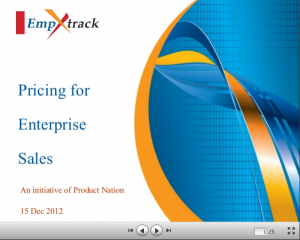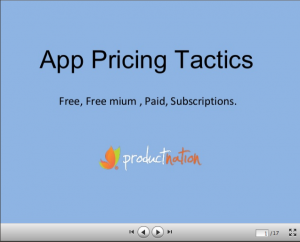When a bunch (around 45-50, I didn’t keep the count) of Product enthusiasts – with experience accumulating into decades – gather at a single place to share their learning on specific topic in a compact & well-moderated session of 2 hours, it’s worth every bit. That’s how I felt coming out of the inaugural session of #PNMeetup – Pricing for Enterprise Sales: Specific & Important Topic, Quality Participation, Richness of Experiences, and Quality Conversations.
The location, Hauz Khas Village in New Delhi, carries a constant buzz and energy. Very apt for a meet-up like this. Kunzum Travel Café (Thanks for being a great host for the event!), should be happy because participants used up every nook & corner of the place. Many of us had to settle down on the carpet with no more sitting or standing space left! Of course, the snacks & coffee was great too. But, that’s not what everyone coming in was specifically looking for (especially since the last 500 yards got harder to make with the traffic and parking situation ;-)).
We need more space…#pnmeetup. @kunzum cafe is full and folks now settling down on the dari #Delhi #startups twitter.com/Product_Nation…
— pn.ispirt.in (@Product_Nation) December 15, 2012
We were looking for some great (practical, experience based, relevant) conversations and takeaways on Pricing. And, there was plenty of it, coming from speakers as well as from the participants. As much as is possible in 2 hours of time, that is, also thanks to some great moderating & counter-questioning by Arvind Jha during speaker sessions, and Rajat Garg & Vivek Agarwal in the un-conference session.
Tushar Bhatia, Founder of Saigun Technologies, set the tone for Enterprise Products Pricing by sharing his experiences on Pricing Strategies and Sales tactics. Tushar emphasized that Pricing is not a linear decision, but a complex process and subject to assessment from multiple parameters. He also differentiated the Pricing Strategy from Sales Process. Pricing, as per him (in the context set of Business Planning, Scalability, Consistency, Standardization, and a reflection of the Value Proposition) is a guide at broader level, while on sales tactics front, one should be willing to consider the customer & geographic circumstances as well. The decision matrix for Pricing decisions typically is pretty complex, and a product undergoes multiple iterations of pricing models

before arriving at the sweet spot. However, various types of customers may need to be assessed in their own contexts when deciding on a deal pricing, especially in the traditional Enterprise Sales scenario.
Tushar also emphasized that the Enterprise Licensing deals should consider not only the product pricing, but also the other costs (such as, hardware) and provisions (such as, for Product Support). The considerations on TCO are critical, because the customers assess the products, not only functionally, but also very critically from an operational viability perspective in longer term. Tushar also laid out few questions that need to be answered while deciding the pricing model. The detailed presentation from Tushar on “Pricing for Enterprise Sales” can be found here.
The discussion, then, veered towards the product pricing strategies in areas such as Telcos, serving also as a cue for Tarun Anand (CTO & Co-founder at Semusi) to pitch in and provide his perspective. He shared his experiences in working with the big Telcos on working out product strategies and pricing models. They tried out various pricing models, in partnership with Telcos especially, and had mixed results over time before arriving at something that seemed to work. However, pricing remains a volatile when dealing with the larger partners and in more complex ecosystems, such as Telcos.
In Tarun’s experience, one needs to ascertain that the partners in the ecosystem are ready to take your product to the market if that is the expectation. It is also important to ensure that the pricing terms & conditions are clear, and you are able to hold the customers as well as partners accountable in the operational limits as much as you can. After all, you want to focus on running the business and do not want complications of financial & legal nature. In the context of Pricing and products strategy, in areas such as VAS, as per Tarun, one needs to be very careful. “VAS is dead” in his words! 🙂
Tarun also emphasized “there are takers for product at ANY price point”. One need to clearly understand whom one wants to target, and also understand that it’s not only a question of moving the pricing point up & down in inverse proportionality with the volume of customer base. There are various triggers for the pricing, one of which is the “premium value perception”, and also the fact that once you move into a market with a particular price point, increasing it later on is almost impossible without hurting your customer base and overall strategy.

The heat in the Mobile Apps makes the App Pricing a very sought after topic, and that’s where Prashant Singh (Co-founder at Signals) came in and provided a good framework for the high level App pricing approach. There are two clear distinct possibilities – Free & Paid. Complete Free, as per Prashant, directly leads to an Ad based model for revenue that shouldn’t be a preferred model as such for most app developers. In fact the question is not whether to go Free or Paid. Question is when is the user ready for monetization. “You hit when the iron is hot, as simple as that”, Prashant says.
Prashant provided a high level framework to judge which approach should be adopted by the App Developers, based on the two parameters: “App Life Span” and “Time to Realization of Value”. Based on a combination of the two, one can decide on the high level strategy (Portfolio/Platform/Utility/Device Embedding/Brand Apps…) and Pricing model (Advertisement, Paid, Transaction based, Freemium, Development level, and so on). Check out this presentation – App Pricing Tactics for more details.
One key point that drew interest was around the Price Point for App at the launch time. Contrary to the normal belief, Prashant says, one needs to launch the app at a price point that is higher than the Median price point for the App store. That provides the App Store an incentive to showcase the App, and it is important since App Stores control the downloads more than the “content” or “quality”, at least until critical mass. Growth Curve of the app can be maintained around Median and depending on the value prop of the App, the baseline pricing can be used at sustenance phase. Another strong point of view from Prashant came around the Advertisement model, which as per him is the last to be considered. And if Ad model is considered, his advice is to “not” let the control away – “Always have your server in loop”.
While all the content and discussion, and few laughs in between, served well to our appetites, snacks were served amidst a quick “Unconference” session moderated by Rajat and Vivek. We discussed and debated on some great points. I’m finding it harder to capture every bit here and I don’t want to be partial to only what I remember right now! I hope that if you attended and are reading this, you would be able to add your takeaways in comments section! 🙂
Overall, I had a great time. The highlight of the session, for me at least, was the richness of experience and passion for products. And I met some really cool folks! Many of us hung out until later in the night and continued the conversations, which is a great sign. A small impetus can go a long way, and I’m very excited that Avinash has triggered this spark that all of us as a community have to fuel into a passionate ecosystem around products. Great initiative, ProductNation! Looking forward to the next edition on Jan 19th 2013!
PS 1: And, there was a cake-cutting for Avinash on his Birthday! Great gesture!
PS 2: Some Tweets from the session!
#PNMeetup “Enterprise decision cycles are long” Absolutely! Sometime too long in India – have felt it many times!
— Kunal Bajaj (@KunBajaj) December 15, 2012
Does product support is only dependable on cost. What about building product for masses and not classes? #PNMeetup interesting myth vs fact.
— Deepak Sharma (@IntellectAssets) December 15, 2012
“There are takers for a product at ANY price point” #pnmeetup
— Ankur Sharma (@AnkurrS) December 15, 2012
Useful tip, launch your mobile app with a markup from the median price. You’ll have a better chance to get a featured tag #PNMeetup
— Gaurav Mishra (@gmishra) December 15, 2012
#PNMeetup with @avinashraghava @jalajboy @shaakunsethi – awesome presentation by @pacificleo on mobile app pricing… 4sq.com/UZgsi9
— Nikhil Wason (@nikhilwason) December 15, 2012





















